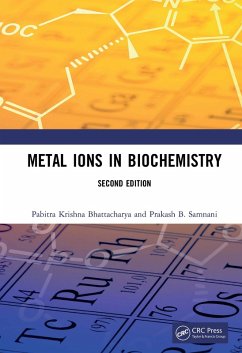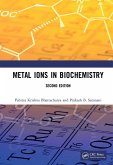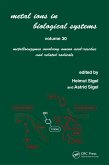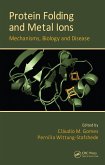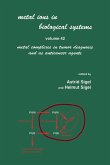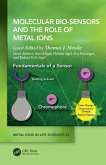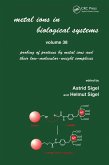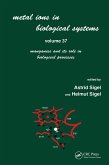89,95 €
89,95 €
inkl. MwSt.
Sofort per Download lieferbar

45 °P sammeln
89,95 €
Als Download kaufen

89,95 €
inkl. MwSt.
Sofort per Download lieferbar

45 °P sammeln
Jetzt verschenken
Alle Infos zum eBook verschenken
89,95 €
inkl. MwSt.
Sofort per Download lieferbar
Alle Infos zum eBook verschenken

45 °P sammeln
- Format: PDF
- Merkliste
- Auf die Merkliste
- Bewerten Bewerten
- Teilen
- Produkt teilen
- Produkterinnerung
- Produkterinnerung

Bitte loggen Sie sich zunächst in Ihr Kundenkonto ein oder registrieren Sie sich bei
bücher.de, um das eBook-Abo tolino select nutzen zu können.
Hier können Sie sich einloggen
Hier können Sie sich einloggen
Sie sind bereits eingeloggt. Klicken Sie auf 2. tolino select Abo, um fortzufahren.

Bitte loggen Sie sich zunächst in Ihr Kundenkonto ein oder registrieren Sie sich bei bücher.de, um das eBook-Abo tolino select nutzen zu können.
The second edition of the book "Metal Ions in Biochemistry" deals exhaustively with the role of metal and non-metal ions in biochemical reactions, and also the effect of deficiency of metal ions, toxic effects of metal ions and use of metal complexes in therapeutics.
- Geräte: PC
- ohne Kopierschutz
- eBook Hilfe
- Größe: 5.2MB
Andere Kunden interessierten sich auch für
![Metal Ions in Biochemistry (eBook, ePUB) Metal Ions in Biochemistry (eBook, ePUB)]() Pabitra Krishna BhattacharyaMetal Ions in Biochemistry (eBook, ePUB)89,95 €
Pabitra Krishna BhattacharyaMetal Ions in Biochemistry (eBook, ePUB)89,95 €![Metal Ions in Biological Systems (eBook, PDF) Metal Ions in Biological Systems (eBook, PDF)]() Metal Ions in Biological Systems (eBook, PDF)272,95 €
Metal Ions in Biological Systems (eBook, PDF)272,95 €![Protein Folding and Metal Ions (eBook, PDF) Protein Folding and Metal Ions (eBook, PDF)]() Protein Folding and Metal Ions (eBook, PDF)84,95 €
Protein Folding and Metal Ions (eBook, PDF)84,95 €![Metal Ions in Biological Systems (eBook, PDF) Metal Ions in Biological Systems (eBook, PDF)]() Metal Ions in Biological Systems (eBook, PDF)340,95 €
Metal Ions in Biological Systems (eBook, PDF)340,95 €![Molecular Bio-Sensors and the Role of Metal Ions (eBook, PDF) Molecular Bio-Sensors and the Role of Metal Ions (eBook, PDF)]() Molecular Bio-Sensors and the Role of Metal Ions (eBook, PDF)142,95 €
Molecular Bio-Sensors and the Role of Metal Ions (eBook, PDF)142,95 €![Metal Ions in Biological Systems (eBook, PDF) Metal Ions in Biological Systems (eBook, PDF)]() Metal Ions in Biological Systems (eBook, PDF)445,95 €
Metal Ions in Biological Systems (eBook, PDF)445,95 €![Metal Ions in Biological Systems (eBook, PDF) Metal Ions in Biological Systems (eBook, PDF)]() Helmut SigelMetal Ions in Biological Systems (eBook, PDF)66,95 €
Helmut SigelMetal Ions in Biological Systems (eBook, PDF)66,95 €-
-
-
The second edition of the book "Metal Ions in Biochemistry" deals exhaustively with the role of metal and non-metal ions in biochemical reactions, and also the effect of deficiency of metal ions, toxic effects of metal ions and use of metal complexes in therapeutics.
Dieser Download kann aus rechtlichen Gründen nur mit Rechnungsadresse in A, B, BG, CY, CZ, D, DK, EW, E, FIN, F, GR, HR, H, IRL, I, LT, L, LR, M, NL, PL, P, R, S, SLO, SK ausgeliefert werden.
Produktdetails
- Produktdetails
- Verlag: Taylor & Francis eBooks
- Seitenzahl: 292
- Erscheinungstermin: 13. Dezember 2020
- Englisch
- ISBN-13: 9781000292640
- Artikelnr.: 60584604
- Verlag: Taylor & Francis eBooks
- Seitenzahl: 292
- Erscheinungstermin: 13. Dezember 2020
- Englisch
- ISBN-13: 9781000292640
- Artikelnr.: 60584604
- Herstellerkennzeichnung Die Herstellerinformationen sind derzeit nicht verfügbar.
Pabitra Krishna Bhattacharya retired as Professor and Head, Department of Chemistry, M S University of Baroda, 9m 2001, after serving for thirty four years. Prior to that, he served in Kurukshetra University, University of Rajasthan (Jaipur), and Vikram University (Ujjain). Prof Bhattacharya obtained MSc and PhD degrees from University of Saugor, MP. He was awarded senior fellowship under Fulbright Hayes programme to carry out post doctoral work in Ohio state University Columbus USA during 1976 - 77. He also worked in University of Sheffield UK in 1987 under INSA Royal Society Exchange Programme. Prof Bhattacharya's teaching and research interests involved quantum chemistry, spectroscopy, coordination chemistry, bioinorganic chemistry and homogeneous catalysis. Thirty seven students obtained PhD degree under his supervision. He presented papers and delivered lectures at various Indian and foreign conferences. He was invited as a speaker at international conference in coordination chemistry, held at Gera, Germany in 1990. Prof Bhattacharya was awarded Prof P Ray memorial medal of Indian Chemical Society in 2000, Platinum Jubilee lecture award of Science Congress in 2001 and Silver medal of Chemical Research Society of India, Bangalore, 2002. He worked as a member of various committees, more notable being, IUPAC, and DST, programme advisory committee. Prof Bhattacharya is the author of three books, Group theory and its Chemical Applications, published by Himalaya Publishing House, Mumbai, Metal Ions in Biochemistry, First Edition, by Narosa Publisher, Delhi, and Threshold of Inorganic Chemistry, 1st edition, published by Himalaya Publishing House, Mumbai.
Prakash B Samnani obtained his MSc and PhD degrees from The Maharaja Sayajirao University of Baroda, Vadodara. After a 2 years stint as Research Officer in Analytical Division of the Advanced Research Center of Sun Pharmaceuticals, he joined the Department of Chemistry of the M S University of Baroda where he is presently working as Professor. With the industrial experience and more than 25 years of teaching and research experience in Chemistry in the University, the author has a number of research publications to his credit. He has published research papers in the area of Analytical Chemistry and Homogeneous Catalysis in journals of National and International repute. He has also authored five books titled Experiments in Chemistry, Chemical Companion, Teaching of Chemical Analysis, Quantitative Chemical Analysis, and Threshold of Inorganic Chemistry, all published by well known publishing houses in India. He has completed research projects funded by UGC, CSIR, DST. His teaching and research interests include Inorganic Chemistry, Analytical Chemistry, especially Chromatographic methods, Environmental Chemistry and Homogeneous Catalysis.
Prakash B Samnani obtained his MSc and PhD degrees from The Maharaja Sayajirao University of Baroda, Vadodara. After a 2 years stint as Research Officer in Analytical Division of the Advanced Research Center of Sun Pharmaceuticals, he joined the Department of Chemistry of the M S University of Baroda where he is presently working as Professor. With the industrial experience and more than 25 years of teaching and research experience in Chemistry in the University, the author has a number of research publications to his credit. He has published research papers in the area of Analytical Chemistry and Homogeneous Catalysis in journals of National and International repute. He has also authored five books titled Experiments in Chemistry, Chemical Companion, Teaching of Chemical Analysis, Quantitative Chemical Analysis, and Threshold of Inorganic Chemistry, all published by well known publishing houses in India. He has completed research projects funded by UGC, CSIR, DST. His teaching and research interests include Inorganic Chemistry, Analytical Chemistry, especially Chromatographic methods, Environmental Chemistry and Homogeneous Catalysis.
1. Structure of Cells and Introduction to Bioinorganic
Chemistry................................................. 1
2. Thermodynamic and Kinetic Properties of Metal
Complexes....................................................17
3 Alkali and Alkaline Earth Metal Ions in Biochemical
Systems................................................. 63
4. Zinc in Biochemical
Systems..........................................................................................................
83
5. Iron in Biochemical
Systems........................................................................................................
103
6. Copper in Biochemical
Systems...................................................................................................
139
7. Cobalt in Vitamin B12 in Biochemical
System............................................................................
157
8. Molybdenum in Nitrogen Fixation in
Plants...............................................................................167
9. Magnesium and Manganese in Photosynthesis in
Plants...........................................................177
10. Less Common Trace Metal Ions in Biochemical
Systems..........................................................187
11. Metal Ion Toxicity in Biochemical
Systems................................................................................
209
12. Metal Complexes in
Therapeutics................................................................................................219
13. Role of Trace Nonmetals in Biochemical
Systems......................................................................231
Chemistry................................................. 1
2. Thermodynamic and Kinetic Properties of Metal
Complexes....................................................17
3 Alkali and Alkaline Earth Metal Ions in Biochemical
Systems................................................. 63
4. Zinc in Biochemical
Systems..........................................................................................................
83
5. Iron in Biochemical
Systems........................................................................................................
103
6. Copper in Biochemical
Systems...................................................................................................
139
7. Cobalt in Vitamin B12 in Biochemical
System............................................................................
157
8. Molybdenum in Nitrogen Fixation in
Plants...............................................................................167
9. Magnesium and Manganese in Photosynthesis in
Plants...........................................................177
10. Less Common Trace Metal Ions in Biochemical
Systems..........................................................187
11. Metal Ion Toxicity in Biochemical
Systems................................................................................
209
12. Metal Complexes in
Therapeutics................................................................................................219
13. Role of Trace Nonmetals in Biochemical
Systems......................................................................231
1. Structure of Cells and Introduction to Bioinorganic
Chemistry................................................. 1
2. Thermodynamic and Kinetic Properties of Metal
Complexes....................................................17
3 Alkali and Alkaline Earth Metal Ions in Biochemical
Systems................................................. 63
4. Zinc in Biochemical
Systems..........................................................................................................
83
5. Iron in Biochemical
Systems........................................................................................................
103
6. Copper in Biochemical
Systems...................................................................................................
139
7. Cobalt in Vitamin B12 in Biochemical
System............................................................................
157
8. Molybdenum in Nitrogen Fixation in
Plants...............................................................................167
9. Magnesium and Manganese in Photosynthesis in
Plants...........................................................177
10. Less Common Trace Metal Ions in Biochemical
Systems..........................................................187
11. Metal Ion Toxicity in Biochemical
Systems................................................................................
209
12. Metal Complexes in
Therapeutics................................................................................................219
13. Role of Trace Nonmetals in Biochemical
Systems......................................................................231
Chemistry................................................. 1
2. Thermodynamic and Kinetic Properties of Metal
Complexes....................................................17
3 Alkali and Alkaline Earth Metal Ions in Biochemical
Systems................................................. 63
4. Zinc in Biochemical
Systems..........................................................................................................
83
5. Iron in Biochemical
Systems........................................................................................................
103
6. Copper in Biochemical
Systems...................................................................................................
139
7. Cobalt in Vitamin B12 in Biochemical
System............................................................................
157
8. Molybdenum in Nitrogen Fixation in
Plants...............................................................................167
9. Magnesium and Manganese in Photosynthesis in
Plants...........................................................177
10. Less Common Trace Metal Ions in Biochemical
Systems..........................................................187
11. Metal Ion Toxicity in Biochemical
Systems................................................................................
209
12. Metal Complexes in
Therapeutics................................................................................................219
13. Role of Trace Nonmetals in Biochemical
Systems......................................................................231
